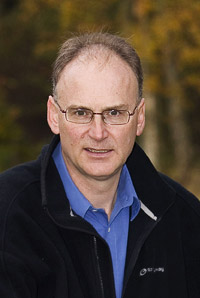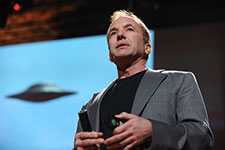LECTURE THIS SUNDAY: best-seller Matt Ridley
You won’t want to miss this lecture!
The Rational Optimist:
How Prosperity Evolves
Sunday, June 20, 2010 at 2 pm
Baxter Lecture Hall, Caltech
MATT RIDLEY, THE AUTHOR OF the bestselling science books Genome, The Red Queen, The Origins of Virtue, and Nature via Nurture, demonstrates in his new book (The Rational Optimist: How Prosperity Evolves) that life is getting better — and at an accelerating rate. Food availability, income, and life span are up; disease, child mortality, and violence are down — all across the globe. Though the world is far from perfect, necessities and luxuries alike are getting cheaper; population growth is slowing; Africa is following Asia out of poverty; the Internet, the mobile phone, and container shipping are enriching people’s lives as never before.
READ more about this lecture…
In this week’s eSkeptic, we present Daniel Greenburg’s article from the archives of Skeptic magazine Volume 11, Number 3 in which he discusses how psychological research shows that our most powerful memories may be untrustworthy.
Dr. Daniel Greenberg earned his B.A., his M.A., and his Ph.D. in experimental psychology from Duke University. Most of his research involves the neurological basis of memory; in the past, he’s conducted case studies of brain-damaged adults as well as studies of healthy adults using functional brain imaging (i.e. fMRI).
Portions of this essay originally appeared in Greenberg, D.L. (2004). “President Bush’s False ‘Flashbulb’ Memory of 9/11/01.” Applied Cognitive Psychology. Copyright John Wiley & Sons Limited. Reproduced with permission.
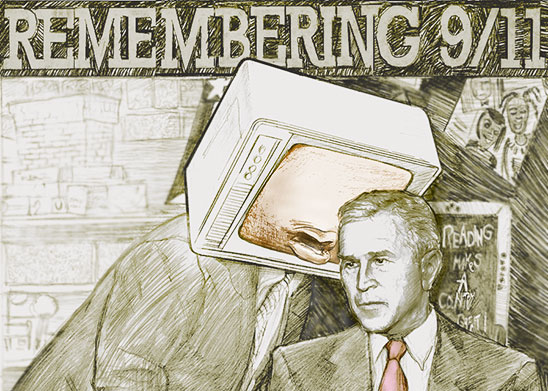
Flashbulb Memories
by Daniel Greenburg
On arrival in New York we caught a cab and headed for the city. The cab had no radio on. As fate would have it, the cabby missed a turn somewhere and we were off the highway, somewhere in Astoria, Queens, I think. We were stopped for a red light when a woman came out of her house screaming and crying. I rolled down the cab window to ask what the matter was… She told me that John Kennedy had just been shot in Dallas. We drove the rest of the way in silence.
— Richard Nixon’s memory of the Kennedy assassination1
Although I was but four and a half years old when [the President] died, I distinctly remember the day when I found on our two white gate posts American flags companioned with black. I tumbled down on the harsh gravel walk in my eager rush into the house to inquire what they were “there for.” To my amazement I found my father in tears, something that I had never seen before, having assumed, as all children do, that grown-up people never cried. The two flags, my father’s tears, and his impressive statement that the greatest man in the world had died constituted my initiation…[into] a world lying quite outside the two white gate posts.
— Jane Addams’s memory of the Lincoln assassination2
MOST OF US CAN TELL STORIES LIKE THESE. Shocking events seem to etch themselves in our minds; we recall them with a clarity and emotional intensity that few other memories can match. We remember more than just the basic facts of the event; we know our personal stories as well — where we were, who told us, and what we were doing when we heard the news. Even trivial details seem to fix themselves in our memories: on the day of the Kennedy assassination, for example, Julia Child remembers that she and her husband were eating fish soup. Some people notice strange and compelling coincidences: Arthur Sulzberger was discussing presidential security when Kennedy’s death was announced; Billy Graham had a sense of foreboding a week before; Bob Hope had just received a signed photograph of himself with Kennedy, which was sitting atop the television on which he heard the news. All of these features are unusual and intriguing, but the long life of these memories stands out above all else. Few of us can remember what we did on the day before a shocking event; as for the day itself, we feel that we can see it in our minds, that we can remember it as though it were yesterday, and we feel that that we cannot possibly forget it.
The vividness and apparent durability of these memories has fascinated psychologists for over a century. In 1899, a psychologist named F. W. Colegrove investigated people’s 34-year old memories of the Lincoln assassination. He found that over two-thirds of the people he interviewed could remember what they had been doing when they heard the news, a result he considered a testament to “the abiding character of vivid experiences.”3 Decades later, when Roger Brown and James Kulik of Harvard University studed memories of shocking events of the 1960s and 1970s they proposed the term “flashbulb memory” to capture what they described as “the primary, ‘live’ quality [of the memories] that is … very like a photograph.” 4 As Brown and Kulik noted, the metaphor is not perfect, as some details are not preserved, but on the whole it aptly describes the strength and clarity of the memories as well as the rapidity with which they are originally stored.
We may have flashbulb memories for private events as well, such as a first kiss or the birth of a child, but the most compelling flashbulbs — the ones that we find ourselves relating over and over — tend to involve shocking historic events. Thus, people have reported flashbulb memories for many occasions, including the Lincoln assassination, the attack on Pearl Harbor, the assassinations of John F. Kennedy and Martin Luther King, the attempted assassination of President Reagan, the 1989 San Francisco earthquake, the Challenger explosion — and, most recently, the September 11th attacks.5
The Strange Case of the President’s Memory
Shortly after 9/11, one particular person’s memories attracted the attention of the Internet’s conspiracy theorists. That person was President George W. Bush, and the controversy arose over apparent changes in his story. The fuss began on December 4, 2001, when the President told a crowd of people how he heard the news about the attacks:
I was in Florida. And my chief of staff, Andy Card — actually I was in a classroom talking about a reading program that works. And I was sitting outside the classroom waiting to go in, and I saw an airplane hit the tower — the TV was obviously on, and I use[d] to fly myself, and I said, “There’s one terrible pilot.” And I said, “It must have been a horrible accident.” But I was whisked off there — I didn’t have much time to think about it, and I was sitting in the classroom, and Andy Card, my chief who was sitting over here walked in and said, “A second plane has hit the tower. America’s under attack.”6
Just over two weeks later, on December 20, the President told a different story during an interview with the Washington Post:
Bush remembers senior adviser Karl Rove bringing him the news, saying it appeared to be an accident involving a small, twin-engine plane. In fact it was American Airlines Flight 11, a Boeing 767 out of Boston’s Logan International Airport. Based on what he was told, Bush assumed it was an accident. “This is pilot error,” the president recalled saying. “It’s unbelievable that somebody would do this.” Conferring with Andrew H. Card Jr., his White House chief of staff, Bush said, “The guy must have had a heart attack”… At 9:05 a.m., United Airlines Flight 175, also a Boeing 767, smashed into the South Tower of the trade center. Bush was seated on a stool in the classroom when Card whispered the news: “A second plane hit the second tower. America is under attack.”7
Then on January 5, 2002, the President’s story changed again:
I was sitting there, and my Chief of Staff — well, first of all, when we walked into the classroom, I had seen this plane fly into the first building. There was a TV set on. And you know, I thought it was pilot error and I was amazed that anybody could make such a terrible mistake. And something was wrong with the plane, or — anyway, I’m sitting there, listening to the briefing, and Andy Card came and said, “America is under attack.”8
Clearly, something is wrong here. In the second memory, the President claims that Karl Rove told him about the first crash, but in the first and third memories, he claims that he saw the news on television. Stranger still, the first and third memories seem impossible: there was no footage of the first plane, at least not at that hour of the morning.9 What could the explanation be? Conspiracy theorists had plenty of suggestions. Sites across the Web erupted with accusations of dishonesty and calls for impeachment. “Bush slip reveals total 9/11 complicity,” screamed freeworldalliance.com:
Complicit factions of the U.S. federal government, including virtually ALL upper-level members of the BushMob, actually FILMED their own attack on New York’s World Trade Center — and Bush has admitted that he WATCHED IT!!!! And there is only one POSSIBLE way such footage COULD have existed: the perpetrators of the WTC attack HAD THEIR OWN CAMERAS IN PLACE TO FILM IT [emphasis in the original].10
The website bushwatch.com took a somewhat more moderate view, noting that “the most benign conclusion, then, is that Bush was not telling the truth when he told Jordan that he saw the first plane hit the first tower prior to his going into the classroom.”11 Even the Guardian, a British newspaper, found Bush’s statements worthy of comment, noting that “the story that he was watching TV contradicts reports from correspondents at the time that he got the news in a phone call.”12
What are we to make of this? Are we obliged to believe that the President is smart enough to carry out a horrific conspiracy to attack America, but dumb enough to reveal it — twice? Should we instead believe that the President lied about what happened — twice but not three times — even though he had much to lose and nothing to gain from such a lie? Or should we believe something else entirely?
Fortunately, scientific studies of memory can offer a more benign explanation. We don’t need to posit irrational lies or a massive conspiracy imperfectly hidden from the eyes of everyday citizens. Instead, we need only consider the frailties of human memory.
The False Memory Phenomenon
All of us know that our memory can fail us — we forget the location of our car keys, the name of our second-grade teacher, or the kind of drink we had with lunch three days ago. But memory can betray us in another way, too: we may also experience false memories — putative “memories” for events that never took place. While forgetting is easy to notice, false memories are much harder to detect because they can seem just like normal memories. Nevertheless, over the last century, hundreds of studies have shown just how common false memories can be.
Consider one of the most straightforward demonstrations of false memory — originally proposed by James Deese — which has been used in introductory psychology classrooms as well as experimental research. An experimenter reads a list of about a dozen words (“bed, rest, awake, tired, dream,” etc.), all of which are related to one particular word, known as the lure (in this case, “sleep”). The listeners are then asked to recall as many words as they can. In one sense, people perform quite well — they can remember most of the words on the list. Yet in one particular way, they perform quite poorly: many people falsely recall hearing the lure, even though the experimenter never read it. This is not just a vague impression or a guess; people will often express great confidence in their memory of the lure, saying that they can “hear” the experimenter’s voice in their minds, or that they remember exactly when in the list it was presented. (In fact, their confidence can be so strong as to be unshakable. When I first watched an instructor try this on her class, a few students simply refused to believe that she never read the lure, instead asserting that she must be lying!)
In another classic experiment, Elizabeth Loftus and John Palmer showed people a videotape of a car accident. They then asked participants a series of questions about what they had seen. One of the questions had two forms: half of the participants estimated how fast the cars had been going when they hit each other; the other half estimated how fast the cars were going when they smashed. This simple one-word difference produced a startling effect: while most people got the question right, participants who received the “smashed” question were more likely to claim that they had seen broken glass, even though there was no broken glass in the original video. In short, our memory of an event can be altered by the way in which someone asks us about it — a problem that proves particularly vexing to police officers and lawyers.
In some cases, people can even have entirely fictitious memories for full-fledged, specific events. In one study, Ira Hyman and Joel Pentland of Western Washington University tried to “implant” a false memory in the minds of their participants. They started by obtaining a list of childhood events from each participant’s parents, and then interviewed each participant about the memories that his or her parents had provided. They also asked each participant about one fictitious memory — a memory of spilling a punchbowl on a bride during a wedding reception — but told participants that all memories, including the punchbowl memory, had been provided by the participant’s parents. If they didn’t “recall” the punchbowl memory during the original interview (and most participants didn’t) they were asked to think about the event or to visualize it in their minds as best they could. When tested several days later, almost 25% of the participants in the experiment claimed to have some memory of spilling the punchbowl. These people didn’t just remember that the experimenter had told them about it, nor did they just claim that they knew that it happened. Rather, they claimed to have a detailed memory of the event itself — and some of them even elaborated on the memory, providing details that the experimenter had never mentioned. This straightforward experimental design — which simply involves asking people to imagine an event they’d never experienced — was enough to create a false memory. Overall, somewhere between 15 to 25% of adults can be induced to create false memories in this way.13 A similar phenomenon may explain False Memory Syndrome, in which fictitious memories of sexual abuse are inadvertently implanted in patients’ minds by therapists who use guided-visualization and other suggestive techniques.14
False Flashbulb Memories
This research provides important and comprehensive demonstrations of the ease with which we can be induced to remember events that never happened. Skeptics, however, might argue that each of these studies leaves out a vital component of the flashbulb memory experience.15 After all, most people find word lists rather dull, while flashbulb memories record some of the most shocking and horrifying events of our lives. Videotapes of car accidents may be more exciting, but they still lack the immediacy and emotional impact of a surprising historic event. As for full-blown false memories of the sort that Hyman and colleagues created, they generally arise after substantial coaxing by an experimenter or a therapist; flashbulb memories need no such help, as they seem fixed in our minds from the start. Moreover, we know that the original flashbulb experience really happened — we know that we heard about the news somehow. Can memories like these really be wrong?
As a matter of fact, yes. The flashbulb metaphor and our own intuition suggest that these memories are accurate and permanent, but experiment after experiment shows that they too can mutate over time. For example, Ulric Neisser and Nicole Harsch developed a questionnaire to assess the consistency of memories for the space shuttle Challenger disaster. The questionnaire asked people to remember the basic facts of their experience, such as where they were, what they were doing, how they heard the news, and so on. They first tested people 24 hours after the explosion; 2.5 years later, some of the participants filled out the questionnaire again. Overall, people performed quite poorly — the average score was just under 3 out of a possible 7. Other studies of Challenger memories yielded similar results: one study by Michael McCloskey and colleagues found that 25% of participants gave at least one inconsistent response after a 9-month delay; John Bohannon and Victoria Symons found that after a 3-year delay, 33% of participants told inconsistent stories. Memories for September 11th also suffer from inconsistencies: studies by Peter Lee and Norman Brown as well as Marilyn Smith and colleagues showed that on average, only 65% of memory details remained consistent between the first test and the second. In fact, Neisser himself has a false memory for the announcement of the bombing of Pearl Harbor. He has always remembered that he was listening to a baseball game on the radio when it was interrupted by an announcement of the Pearl Harbor attack — but the attack occurred on December 7, 1941, and no baseball is played in December. Thus, numerous studies have shown that people experience false flashbulb memories for a wide variety of events.
In spite of all this, people feel quite confident in their memories for shocking events. Neisser and Harsch showed their participants the stories they had written during the first session. Even when their stories had changed considerably, people still expressed surprise at the difference and didn’t revert to their first memory:
No one who had given an incorrect account in the interview even pretended that they now recalled what was stated on the original record. On the contrary, they kept saying “I mean, like I told you, I have no recollection of it at all” or “I still think of it as the other way around.” As far as we can tell, the original memories are just gone.16
In a recent study, Jennifer Talarico and David Rubin, two of my colleagues at Duke University, conducted a detailed examination of this phenomenon. On September 12, 2001, they asked people to provide two memories: one for September 11th and another for an everyday event that happened a few days before the attacks. When they tested the participants a second time (1, 6, or 32 weeks later), they found that both memories contained a similar number of inaccuracies. Nevertheless, confidence in the everyday memory declined over time, while confidence in flashbulb memories remained high. While we may think that our flashbulb memories are as permanent as a photograph, they decay just as quickly as memories for everyday events.17
But can the inconsistencies be as substantial as those in the President’s stories? In fact, they can. Consider the stories told by one of the people in Neisser and Harsch’s study:
Memory 1 (24 hours after the event): I was in my religion class and some people walked in and started talking about it. … Then after class I went to my room and watched the TV program talking about it…
Memory 2 (2.5 years later): When I first heard about the explosion I was sitting in my freshman dorm room with my roommate and we were watching TV. It came on a news flash…18
This person’s memories, along with the memories of nine other people in the study, changed in the same way. They originally remembered hearing the news from another person, but later came to remember that they saw it on TV — exactly the change that happened between President Bush’s second and third recollections. There are even more examples: In a study by Hans Crombag and colleagues, 60% of participants reported seeing footage of the crash of an El Al jet in Amsterdam, even though no such footage exists. And, in Kathy Pezdek’s study of memories for September 11th, 73% of participants made precisely the mistake that the President made, claiming to have seen the footage of the first plane crash on September 11th itself.19
The scientific evidence is clear. People frequently experience false flashbulb memories. Further, people can experience false flashbulb memories for nonexistent footage of a plane crash. This kind of memory error is not just possible, but commonplace.
The Source of False Memories
What makes these memories change over time? We can’t know for certain, because we don’t know how the person really heard about the event and we don’t know for certain what he or she experienced between the first test and the second. Still, studies of everyday memory offer some insights. For example, Bill Brewer of the University of Illinois showed that people make similar errors with everyday memories, not just flashbulbs. In one of his studies, he asked people to record daily events in diaries; in a later test, he asked them to relate what had happened to them at a particular point in time. When he checked their answers against the diaries, he found that people often responded with a fairly accurate story about something that happened at a completely different time — a mistake he called the “wrong time slice” error. As Neisser showed, John Dean suffered from a similar problem during his Watergate testimony; while his memory for conversations often seemed quite vivid and detailed, later reviews of the Watergate tapes showed that he tended to combine statements from separate conversations that had occurred on different days.
In the case of flashbulb memories, we can safely assume that Neisser and Harsch’s participants, Pezdek’s participants, and George W. Bush himself all saw footage of the event on television, since it was shown again and again in the weeks and months following the attacks. Then, when they were asked to tell their story again, they did just what the people in Brewer’s study did: they accurately remembered what they saw, but misjudged when they first saw it.
Why do people falsely recall that time slice instead of the correct one? Part of the answer lies in the power of a picture. Flashbulb events generally involve strong and vivid images, which is what led Brown and Kulik to propose the flashbulb metaphor in the first place. We have known for millennia that images like these are highly memorable, which is why many memoryimprovement techniques make use of them; it makes sense, then, that people would remember these images particularly clearly. Moreover, a strong mental image affects judgments about memory. For example, when people retrieve a mental image, they generally feel more confident that the memory is accurate. If you’re wondering whether you turned off the stove, you’re likely to conclude that you did if you can conjure up a mental picture of yourself doing it. But while images affect confidence in memory, they can also be misleading. They can bring about memory errors precisely because they are easy to generate, easy to modify, and easy to remember. When people reflect on an event that they have not seen, for example, they may imagine how it must have looked. These images are memorable as well, and can easily be mistaken for real memories — which is just what happened in Hyman and Pentland’s study. In other words, it comes as no surprise that people remember visual images more than anything else — but it also comes as no surprise that these images can be modified, fabricated, or attributed to the wrong time.
The organization of the memory may also play a role. People often relate memories in the form of stories, giving them a logical flow as well as a beginning, middle, and end. Gaps in the story can be reconstructed based on a script, a general idea of what usually happens in such a situation. Neisser and Harsch, for example, propose that the participants in the Challenger study retrieved a vivid visual image, and knew it was quite reasonable that they would have heard about the explosion from TV; then, over time, they developed the erroneous belief that the TV had been the source of the news.
These phenomena provide a simple, uncontroversial explanation of the President Bush’s changing story. In particular, they show how Memory 2 can be related to the implausible Memories 1 and 3. According to Memory 2, his advisor Karl Rove told the President about the first crash, but, as in many such situations, the early information was inaccurate. The President was not told that it was an attack involving a passenger jet, but rather that it was a small twinengine plane — a surprising and disturbing event, to be sure, but not on the level of a national emergency, and nowhere near as shocking as what was to come. In any case, the President, like most Americans, presumably saw the footage many times in the subsequent months, including footage of the first crash when it became available. Then, when the President tried to remember how he heard about the first attack, he did just what so many other people have done, retrieving information from the wrong time slice and recalling a vivid, memorable visual image instead of the more mundane statements of Karl Rove.
The President may also have worked this image into a complete narrative. According to one report, footage of the aftermath of the first crash (but not the crash itself) was shown at the school, as people sought out televisions to find out what was going on. In other words, the President may have seen the end of this sequence of events, but not the beginning. After seeing the footage of the crash, he may have incorporated it into the video he saw at the school, completing the story by adding cause to effect. In the few seconds or so it took him to formulate an answer to the question, this story may have seemed reasonable enough; there was footage, after all; people do tend to learn these things from TV; and he was watching TV that morning. It is worth noting that the President sounded a bit tentative when relating Memories 1 and 3: both times, he started by discussing the second attack, only to interrupt himself and talk about the first; when he does talk about the first crash, he backtracked, making statements like “the TV was obviously on.” Such hesitations and revisions create the impression that the President was reasoning it out — perhaps reconstructing it — as he went along.
The President’s shifting memory does differ in one important respect from the memories of Neisser and Harsch’s participants. In that study, memory errors were irreversible once they had been established. Even when participants were confronted with their original memories — which they themselves had written down — they did not change their stories; they did not suddenly remember the event as they originally had. The President’s memory does not fit this pattern, though: he first reported an implausible memory, then switched to a plausible one, then changed back to the implausible version. (The disparity in delay intervals may account for this difference: the President’s recollections all took place within the space of a month, but Neisser and Harsch’s participants were retested after three years.)
That aside, we should give the President some credit: although his memory of the first crash changed from one point to the next, his memory of the second was quite consistent. On all three occasions, he remembered that he was sitting in the classroom when Andy Card walked in and told him about it (a memory perhaps bolstered by a widely-published photograph of Card whispering in the President’s ear). Moreover, his memory of Card’s statement remained the same from one point in time to the next, with the President using almost the same words every time.
All of the available scientific evidence suggests that we don’t need to resort to any wild conspiracy theories. Instead, the studies on false memory suggest that a simple and commonplace mistake best explains the changes and implausibilities in the President Bush’s story. And they suggest that our own memories — no matter how vivid and realistic they may seem — must be regarded with skepticism too.
References
- Berendt, J. 1973. “Where Were You?” Esquire. November.
- Addams, J. 1992. From J. K. Conway (Ed.), Written by herself. New York: Vintage, 506–525.
- Colegrove, F. W. 1899. American Journal of Psychology, 10, 255.
- Brown, R. and J. Kulik. 1977. Cognition, 5, 74.
- Of course, the phenomenon is not limited to the United States. Many UK residents experienced flashbulb memories of the resignation of Margaret Thatcher, the Hillsborough football disaster, and the death of Princess Diana; Scandinavians often have flashbulbs of the assassinations of Olaf Palme and Anna Lindh; and residents of Turkey have flashbulbs of the death of Atatürk or the major earthquake in 1999.
- “President Holds Town Meeting.”2001. http://transcripts.cnn.com/TRANSCRIPTS/0112/04/se.04.html.
- Balz, D. and B. Woodward. 2002. The Washington Post, January 27, A1, A11.
- “President Holds Town Hall Forum.” 2002. www.whitehouse.gov/news/releases/2002/01/20020105-3.html.
- Later on, it turned out that a camera crew had accidentally caught the first impact into the World Trade Center on tape while filming an unrelated program. As best I can determine, this footage was not made available until September 12th. There is nothing to suggest that it was broadcast “live” in time for the President to see it early that morning.
- “Bush Slip Reveals Total 9/11 Complicity.” 2001. www.freeworldalliance.com/newsflash/pre_2002/newsflash1100.htm
- “Politex’s Bush Watch for Bush Lies.” 2001. www.bushnews.com/bushlies.june.htm
- Engel, M. 2001. The Guardian. December. www.guardian.co.uk/september11/story/0,11209,612354,00.html.
- There are far too many studies on false memory to discuss here; for a review, see: Bjorklund, D. (Ed.) 2000. False Memory Creation in Children and Adults. Mahwah, NJ: Lawrence Erlbaum Associates.
- For more on False Memory Syndrome, see Skeptic Vol. 2, No. 3, 58–61 and Skeptic Vol. 3, No. 4, 36–41.
- This assertion should not be construed as a slight against the experimenters; it would obviously be unethical to replicate the horror of flashbulb memory experiences in the laboratory.
- Neisser, U., and Harsch, N. 1992. From U. Neisser and D. Winograd (Eds.), Affect and Accuracy in Recall. New York: Cambridge University Press, 21.
- A few research projects have documented strikingly consistent flashbulb memories, including a study of the Thatcher resignation by Conway and colleagues as well as a study of Turkish memories for September 11th by Tekcan and colleagues. On the whole, though, most studies show that flashbulb memories accumulate errors over time — far more errors than one would expect, given how confident people claim to be.
- Neisser and Harsch, op. cit., 9.
- For more studies of flashbulbs, see: Conway, Martin. 1995. Flashbulb Memory. Hillsdale, NJ: Lawrence Erlbaum Associates.
Skeptical perspectives on false memories and faulty thinking
-
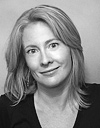 Abducted! How People Come to Believe
Abducted! How People Come to Believe
They Were Kidnapped by Aliens
(DVD $23.95) with Dr. Susan Clancy -
SINCE THERE IS NO EVIDENCE that extraterrestrials have been visiting Earth and abducting humans, how could anyone believe they were abducted by aliens? Harvard post-doc psychologist Susan Clancy interviewed and evaluated “abductees,” listening closely to their stories — how they struggled to explain something strange in their remembered experience, how abduction seemed plausible, and how, having suspected abduction, they began to recollect it, aided by suggestion and hypnosis. Read more…
-
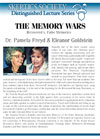 The Memory Wars: Recovered v. False Memories
The Memory Wars: Recovered v. False Memories
(DVD $23.95) with Dr. Pamela Freyd & Eleanor Goldstein -
Pioneering activists and foremost authorities in the field, Freyd and Goldstein, lead the fight against false accusations of child molestation. They explore the ongoing controversy over the nature of memory, particularly the theory that memories can be “repressed” and later “recovered” through special therapeutic techniques such as hypnotic regression, fantasy role playing, and dream interpretation. ORDER the DVD…
-
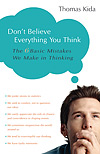 Don’t Believe Everything you Think:
Don’t Believe Everything you Think:
The 6 Basic Mistakes We Make in Thinking
(hardback $19) by Thomas Kida -
This enlightening book discusses how to recognize faulty thinking and develop the necessary skills to become a more effective problem solver. Author Thomas Kida identifies “the six-pack of problems” that leads many of us unconsciously to accept false ideas. Read more…

Skepticality
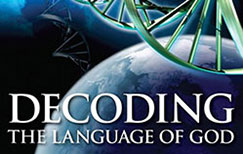
Decoding the Language
of God
This week on Skepticality, Swoopy talks with geneticist Dr. George C. Cunningham, author of Decoding the Language of God: Can a Scientist Really Be a Believer? This book serves as a point-by-point rebuttal of the 2006 bestseller The Language of God: A Scientist Presents Evidence for Belief, by Dr. Francis S. Collins.
Dr. Collins was the head of the Human Genome Project during its final phases, presiding over one of the greatest scientific achievements of all time. And yet, some skeptics expressed unease about Dr. Collins’ 2009 appointment as the Director of the National Institutes of Health. At issue were the award-winning geneticist’s beliefs that our “genetic code is, after all, God’s instruction book” — and that God himself does not need an explanation since he is beyond the universe.
In this interview, Dr. Cunningham respectfully questions the proof Dr. Collins offers for his beliefs, including the Bible and the writings of C.S. Lewis. Additionally, Decoding the Language of God serves as a primer for good critical thinking, discussing points of conflict between naturalistic explanations of reality (which are anchored in scientific research) and supernatural interpretations (which are not). Cunningham’s well-reasoned discussion will appeal to people across a wide spectrum of belief and unbelief.
MonsterTalk
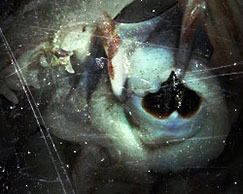
Cthulhu Rises
In this special literary edition, MonsterTalk ventures into a dark domain that can be confidently called fiction: the monstrous, genre-defining oeuvre of horror writer Howard Philips Lovecraft. Joined by noted Lovecraft scholar Robert M. Price and biologist PZ Myers, the MonsterTalk hosts discuss Lovecraft’s life and works, and dare to confront his most famous creation: the vast alien monstrosity Cthulhu. Can the hosts gaze into the shrieking outer darkness and return with their sanity intact? Find out on this episode of MonsterTalk!

NEW ON SKEPTICBLOG.ORG
The Pattern Behind Self Deception
In this week’s Skepticblog post, Michael Shermer says the human tendency to believe strange things — from alien abductions to dowsing rods — boils down to two of the brain’s most basic, hard-wired survival skills. He explains what they are, and how they get us into trouble.


